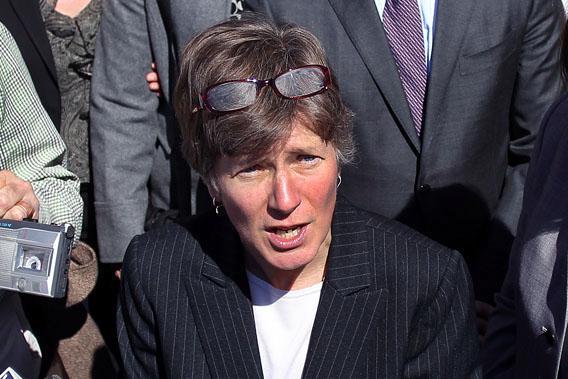On Wednesday morning, the Supreme Court issued its decision in United States v. Windsor, voting 5–4 to strike down the federal Defense of Marriage Act. Tonight, as proponents of same-sex marriage celebrate the decision, they should be sure to raise a glass to an attorney and activist named Mary Bonauto, who has been called the mastermind of the legal strategy that eventually led to DOMA’s collapse. Bonauto works for a Massachusetts-based gay rights organization called Gay and Lesbian Advocates and Defenders, or GLAD. She has had a hand in pretty much every major gay marriage legal victory over the past 20 years. As Roberta Kaplan, the lawyer who argued United States v. Windsor, put it in a March New York Times piece, “No gay person in this country would be married without Mary Bonauto.”
In 2001, Bonauto and GLAD filed Goodridge v. Department of Public Health, a lawsuit that challenged Massachusetts’ decision to deny marriage licenses to several same-sex couples. In 2003, the Massachusetts Supreme Court ruled in Goodridge’s favor, and Massachusetts became the first state to legalize gay marriage. Though it might seem now as if the victory was inevitable, it was actually the result of a deliberate legal strategy. As Richard Thompson Ford put it in Slate in 2004, Bonauto and her colleagues “identified a sympathetic court and political climate, carefully selected a compelling plaintiff, litigated the constitutional issue in court, and secured a judicial victory.”
Bonauto followed a similar template in 2009, when she filed Gill v. Office of Personnel Management, a case that sought to challenge Section 3 of DOMA. Passed in 1996, DOMA defined marriage, for federal purposes, as the union of a man and a woman. As Kenji Yoshino wrote in Slate, Gill v. Office of Personnel Management was filed “on behalf of eight married same-sex couples and three people who survived their same-sex spouses.” The most compelling plaintiff, perhaps, was Dean Hara, who had married former congressman Gerry Studds in 2004. Here’s Yoshino:
After 13 years together as a couple, Studds and Hara married in Boston in 2004, when Massachusetts allowed them to do so. Two years later, Studds did not come home from his morning walk with their dog, because he had passed out from a blood clot in his lung. He died in the hospital. Massachusetts treated Hara as a surviving spouse, by, for instance, releasing Studds’ remains to him. The federal government, in contrast, treated Hara as if he and Studds had never married. Hara was denied the lump-sum benefit to which the Social Security Act entitles surviving spouses and was denied the annuity he would have received as the spouse of a federal employee.
But despite these moving personal stories, many wondered whether the lawsuit was the right move. As a Washington Post article put it in 2009, “Activists and legal strategists historically have avoided taking the issue to a narrowly divided Supreme Court, fearing a major setback.” The dominant strategy, up until Gill, had been to pursue the same-sex marriage issue at the state level. And that hadn’t been going so well—less than a year earlier, California voters had passed Proposition 8, a ballot initiative that adopted DOMA’s definition of marriage. There was no great reason to think the Supreme Court would decide differently.
These worries were unfounded. In 2010, district court Judge Joseph Tauro ruled in Bonauto’s favor and invalidated a key section of DOMA. As Linda Hirshman wrote in Slate at the time, Tauro’s decision “decimated the Obama Justice Department’s rationale for DoMA as a legitimate effort to preserve the existing social order to buy time for society to digest the controversial idea of same-sex marriage. … Tauro concluded that DoMA was driven only by animus against gay people. And animus alone is not a legitimate basis for the government to act.”
Bonauto must have had every expectation that Gill would eventually make it to the Supreme Court. Those hopes were dashed when Elena Kagan was confirmed as a justice in 2010. As solicitor general of the United States, Kagan had apparently discussed legal strategies for Gill with Department of Justice colleagues; as a Supreme Court justice, she would have had to recuse herself if Gill was taken up.
Thus, the Supreme Court heard United States v. Windsor instead. “You’d have to be an inanimate object not to be disappointed,” Bonauto said—but she put her disappointment aside and coordinated the amicus briefs filed in support of Windsor. The rest is history. And history shouldn’t forget the contributions of Mary Bonauto.
Read more from Slate’s coverage of gay marriage cases at the Supreme Court.
